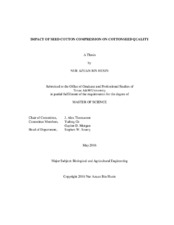| dc.description.abstract | Cotton is harvested as seed cotton, which includes fiber attached to seeds mixed with extraneous matter like leaves and stems. A module builder is used to compress the seed cotton into large rectangular modules that allow in-field storage until being transported to a ginning facility, where the fiber and seed are separated and cleaned. On-board module-building systems are now being used on harvesters and offer virtually continuous harvesting, without the need to transfer seed cotton to a separate module builder. With their smaller size and shape, these packages could possibly be transported more economically by loading multiple packages on a truck. However, their density is similar to traditional modules, so any transport advantage is minimal. Transportation costs could be reduced significantly by creating higher-density cotton packages at harvest. Compression of seed cotton to levels observed with module-building systems has not proven to damage cottonseed, but some research has shown that higher compression levels could cause damage. Moisture content and storage duration may also influence the effect of compression on the seed. The objective of this research was to quantify the effects of these factors, individually and in combination, on cottonseed across two cotton varieties. Humidity chambers were used to achieve desired experimental seed cotton moisture levels. A miniature bale press (16.6 x 8.3 x 6.2 in.) was used to compress bales of seed cotton to different densities. Germination and seed crackage were quantified to determine the impact on the cottonseed. Data analyses indicated that compression density, moisture content, storage time and position of the sample in the bale were all significantly related to seed damage; however, cotton variety was not significantly related. Moisture was most strongly related to reduction in germination, while compression density was most strongly related to increasing crackage. Compression above 24 lbs/ft^3 was clearly associated with higher percentages of cracked seed. | en |


